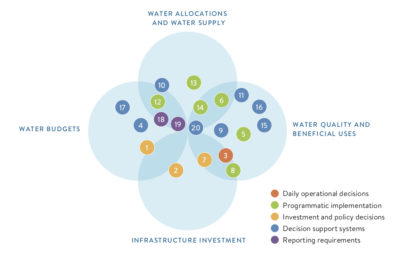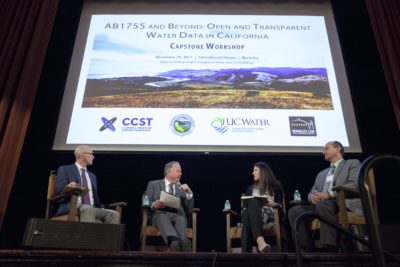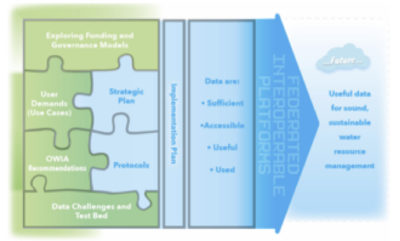Progress on California water data
Michael Kiparsky and Alida Cantor
Water data has become quite a hot topic in California, and rightly so: throughout the state, decision-makers desperately need better information to guide their efforts to better manage this resource. Recent legislation has gotten us to the starting line, but how well new data platforms ultimately serve water management will depend on clear thinking and bold action during implementation. Fortunately, there has been quite a range of recent activity on water data, including some of our own here at CLEE.
AB 1755
California’s Open and Transparent Water Data Act (AB 1755), passed in 2016, focuses on data integration and interoperability. The bill requires the Department of Water Resources (DWR), in consultation with the State Water Resources Control Board (SWRCB), the Department of Fish and Wildlife (CDFW), and the California Water Quality Monitoring Council (CWQMC) to create and maintain a statewide integrated water data platform. AB 1755 requires that these state agencies coordinate and integrate existing water and ecological data from local, state, and federal agencies.
AB 1755 presents an opportunity for significant strides in improving water policy, management, and decision making through the improved provision of data, but the passage of the bill does not, on its own, guarantee that a user-oriented data platform will be successfully developed.
In sum, AB 1755 opens the door for innovation and leadership on water data, but will the state walk through it?
Approaches to implementation
CLEE’s work on this topic originated with the following hypothesis: If we are to enable the holy grail of data-driven decision making for California water management, then we need to start by understanding and articulating the needs of decision makers. In turn, this understanding of how decision makers use (or would like to use) data should directly inform the design of data systems.
A contrasting approach to data system development could be thought of as an “if you build it they will come” model, in which it is assumed that users will make the most of whatever is offered by technical developers. Our thoughts about the better approach have not been a secret. But the experiment to make decision-driven data provision a reality remains in progress.
Recent actions on implementation: Toward decision-driven data provision
An actual data system remains in its infancy and it is too early to evaluate outcomes. Nevertheless, the activity to date is very encouraging. Here we summarize a few ongoing parallel efforts.
Stakeholder engagement and use case development
In 2017, UC Water, the California Council on Science and Technology (CCST), and DWR joined together to examine how user needs could be incorporated into implementation of AB 1755 and into a broader vision for water data systems in California. Through a series of workshops, we engaged a range of data users and data providers to systematically analyze data needs for decision making.
In conjunction with stakeholders and collaborators, we applied the concept of “use cases,” often used to reflect users’ needs in software development projects, to water data. We developed a method to generate use cases in support of AB 1755 implementation. Along with stakeholders, we then generated an initial sample of twenty use cases that analyze how decision-makers use (or could use) data, covering a range of topics from water supply to water quality to long-term infrastructure investments (Figure 1).

From this exercise, we learned that clearly articulating the decision context for water data use can require substantial effort and clear thinking. We also learned that doing so can reveal basics about water data needs: for example, identifying data sets that are commonly relied upon, identifying different types of data gaps, and emphasizing the need for accessibility and interoperability between data sets to aid in decision making.
Report: Data for Water Decision-making
Based on the workshops, the use cases, and additional research, our multi-institution team produced a report, Data for Water Decision Making, that argues that data systems must not only be open and transparent, but must also be relevant to the needs of decision makers.

The emergent conclusions from our report can help steer state agencies and inform stakeholders as California solidifies its vision and process for modernizing its water data system. If the state of California is to successfully navigate its current opportunity to develop an open and transparent water data system that effectively informs decision making, it should incorporate the following considerations (discussed in further detail in the report) into its planning.
- To ensure relevance, an understanding of the way data is used in decision making should guide the development of data systems.
- A wide variety of data must be highly accessible and interoperable to serve many different contexts.
- Data gaps and limitations take a variety of forms, including availability, accessibility, and usability, and will need to be filled in distinct ways.
- For California water, an integrated data system will need to connect data from multiple independent sources, while keeping those independent systems as autonomous entities.
- A water data system must address needs for data at multiple resolutions, and in multiple distinct forms and formats.
- Ultimately, the goal is not only data provision, it is enabling the production of information (data that have been processed in such a way as to be useful).
- Engagement between data system developers and end users is, ideally, an ongoing and iterative process.
- Basing water data on principles of usability and stakeholder engagement requires robust cyberinfrastructure, good governance, and stable funding.
Developing data and information in a useful and usable form requires not only resources, it requires substantial commitment to the processes of building relationships and working with stakeholders. The current momentum and collaborative efforts between agencies and stakeholders are encouraging progress towards actualizing data-driven decision making for California water.
State progress and related efforts
In January 2018, DWR released a progress report detailing their work to date in implementing the Open and Transparent Water Data Act. The progress report includes an initial draft of a strategic plan as well as preliminary protocols (both of which are legislative requirements of AB 1755). In the draft strategic plan, DWR articulates a vision of developing “useful data for sound, sustainable water resource management.” Aligned with this vision, DWR’s goals are to ensure that data are sufficient, accessible, useful, and used. We wholeheartedly support these goals, which are framed around the guiding principle that data should be available in forms that facilitate decision making. We applaud DWR’s adoption of the principle of user-centered data provision as an important philosophical and substantive foundation for generation of an effective data system.

In parallel with the above efforts, the UCSD Supercomputer Center is developing the technical foundation for a federated data system through their Open Water Information Architecture (OWIA). A federated data system connects multiple independent data systems through common standards and conventions, while keeping those independent systems as autonomous entities. Such systems can allow individual data providers to continue to control their own data management while increasing interoperability. The process of developing OWIA has also augmented state agencies’ communication, both of which will be crucial to generating global agreement and coordination on the shape of a data system.
Other related efforts moving forward are illustrated in DWR’s approach to AB 1755 implementation (Figure 3). These efforts include plans for data challenges and “test beds” to engage data providers, data users, and platform operators in developing a system that supports continuous improvement. Ongoing efforts also include an exploration of governance and financing models for long-term sustainability of California’s water data system, a topic we identified as crucial in one of the key recommendations in our report.
Conclusions
It is a fertile time for progress on water data in California. Agencies and stakeholders are laying solid groundwork, demonstrating leadership and taking risk, and progress is encouraging.
This post discusses only a few of the activities around the state on water data, so we may be facing an embarrassment of riches in the form of copious analysis, pilots, and ideas in coming years. Hopefully this continued attention can help keep water data topic on the agenda of legislators and state agency staff.
Ultimately, we hope that the state continues to frame AB 1755 implementation around meeting the needs of decision makers and other end users of data, improving the accessibility and usefulness of California’s water data systems with the ultimate goal of better management of California’s water and environmental systems.
Further reading:
Alida Cantor, Michael Kiparsky, Rónán Kennedy, Susan Hubbard, Roger Bales, Lidia Cano Pecharroman, Kamyar Guivetchi, Christina McCready, and Gary Darling. 2018. Data for Water Decision Making: Informing the Implementation of California’s Open and Transparent Water Data Act through Research and Engagement. Center for Law, Energy & the Environment, UC Berkeley School of Law, Berkeley, CA. 56 pp. https://doi.org/10.15779/J28H01
Reader Comments
One Reply to “Progress on California water data”
Comments are closed.






“Data gaps and limitations take a variety of forms, including availability, accessibility, and usability, and will need to be filled in distinct ways.”
The most basic need is data itself. The US Geological Survey only provides data up to 2010 and most of that data is estimated. Even that data is limited because private well extraction is not monitored and reporting has been and continues to be unenforceable. Sensor technology for public water resources is antiquated (snowpack is still measured by digging a hole and using a stick, and monitor wells are sampled by dropping a plumb line) and less than minimal.
If California can expect an “embarrassment of riches” from copious analyses, pilots and ideas based on currently available data, the embarrassment should come from the poverty of data.